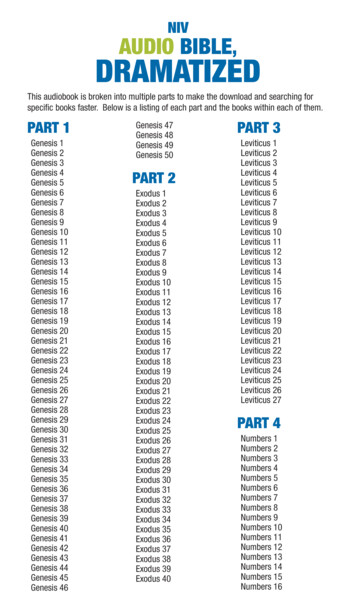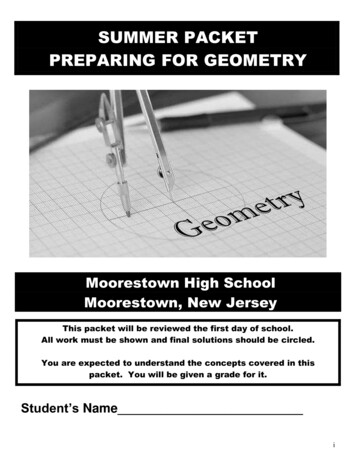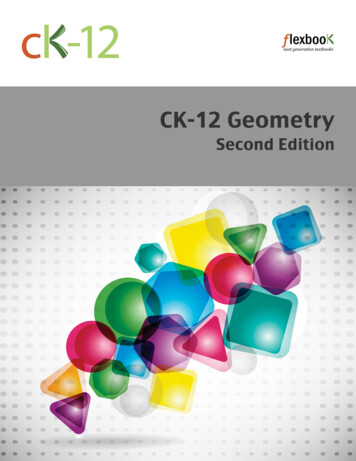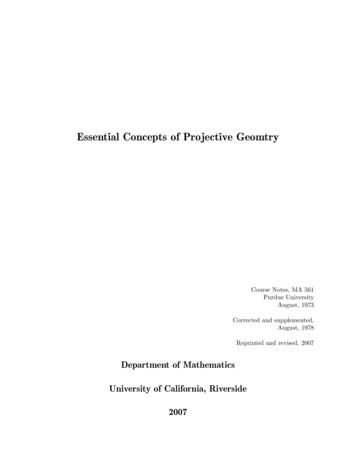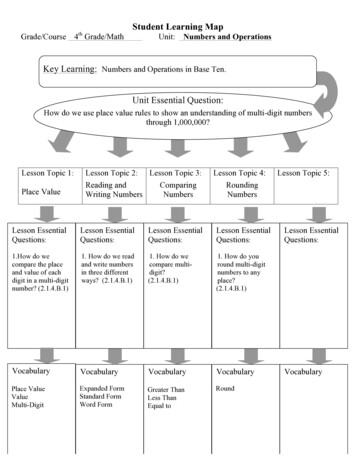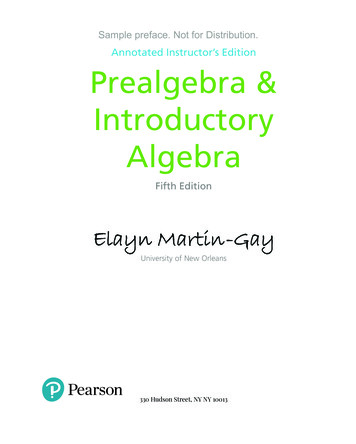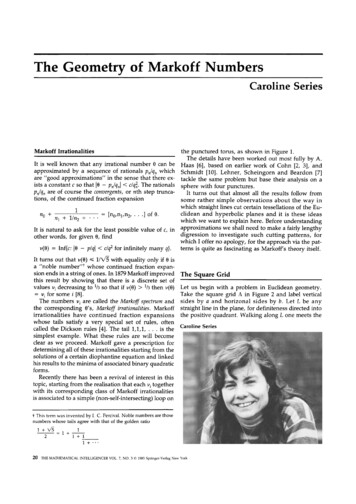
Transcription
The Geometry of Markoff NumbersCaroline SeriesMarkoff IrrationalitiesIt is well known that any irrational number 0 can beapproximated by a sequence of rationals pn/qn whichare "good approximations" in the sense that there exists a constant c so that 10 - pn/qnl c/q 2. The rationalsPJqn are of course the c o n v e r g e n t s , or nth step truncations, of the continued fraction expansionno 1n 1 1/n 2 . . . [n0,nl,n 2. . . . ] of 0.It is natural to ask for the least possible value of c, inother words, for given 0, findv(0) Inf{c: 10 - P/ql c/q 2 for infinitely many q}.the punctured torus, as shown in Figure 1.The details have been worked out most fully by A.Haas [6], based on earlier work of Cohn [2, 3], andSchmidt [10]. Lehner, Scheingorn and Beardon [7]tackle the same problem but base their analysis on asphere with four punctures.It turns out that almost all the results follow fromsome rather simple observations about the w a y inwhich straight lines cut certain tessellations of the Euclidean and hyperbolic planes and it is these ideaswhich we want to explain here. Before understandingapproximations we shall need to make a fairly lengthydigression to investigate such cutting patterns, forwhich I offer no apology, for the approach via the patterns is quite as fascinating as Markoff's theory itself.It turns out that v(0) 1/V with equality only if 0 isa "noble number ''t whose continued fraction expansion ends in a string of ones. In 1879 Markoff improved The Square Gridthis result by showing that there is a discrete set ofvalues v i decreasing to 1/3 so that if v(0) 1/3 then v(0) Let us begin with a problem in Euclidean geometry.Take the square grid A in Figure 2 and label vertical v i for some i [8].The numbers v i are called the M a r k o f f s p e c t r u m and sides by a and horizonal sides by b. Let L be a n ythe corresponding O's, M a r k o f f irrationalities. Markoff straight line in the plane, for definiteness directed intoirrationalities have c o n t i n u e d fraction expansions the positive quadrant. Walking along L one meets thewhose tails satisfy a very special set of rules, oftencalled the Dickson rules [4]. The tail 1,1,1 . . . . is the Caroline Seriessimplest example. What these rules are will becomeclear as we proceed. Markoff gave a prescription fordetermining all of these irrationalities starting from thesolutions of a certain diophantine equation and linkedhis results to the minima of associated binary quadraticforms.Recently there has been a revival of interest in thistopic, starting from the realisation that each v i togetherwith its corresponding class of Markoff irrationalitiesis associated to a simple (non-self-intersecting) loop ont This term w a s i n v e n t e d by I. C. Percival. N o b l e n u m b e r s are thosen u m b e r s w h o s e tails a g r e e w i t h th a t of the g o l d e n ratio1 X/5--21-1 --1 11 .20 THE MATHEMATICALINTELLIGENCERVOL. 7, NO. 3 9 1985 Springer-VerlagNew York
sides a,b in a certain sequence, babbabbbabbabbab in thediagram, which we shall call the cutting sequence of L.(If L goes t h r o u g h a vertex, record the sequence aseither ab or ba.) The problem which we pose is this:describe precisely which sequences of a's and b's occur ascutting sequences of lines in the plane.Figure 3 depicts L d r a w n horizontally with the positions of the a's a n d b's marked along its length. If [3denotes the distance along L between two vertical segments and o is the distance between horizontal segments t h e n K slope (L) [3/oc If l w e m a k etwo observations:Observation 1. The appearances of a are isolated, that is,b e t w e e n any two a's is at least one b.Observation 2. Between a n y two a's there are either [ ]or [ ] 1 b's. (Here [h] is the integer part of .)Of course, if 1, the roles of a and b are reversed,and in observation 2 we read 1/ for k. If L were directed into some other quadrant we w o u l d replace aby a-1 and b by b-1 as appropriate.Let us call a n y sequence of a's and b's satisfying 1and 2, w h e t h e r or not it is obtained as the cuttingsequence of some L, almost constant, a n d call the exp o n e n t [)q or [1/M its value.Given any almost constant sequence s of value n, seta' ab n, b' b. It is clear that we can rewrite as asequence s' in the symbols a', b', called the derivedsequence of s. Of course, s' m a y itself be almost constant, in which case we m a y derive it again. Call asequence which can be derived arbitrarily m a n y times,characteristic.The solution to our problem is n o w remarkably neat:The cutting sequence of a line L is characteristic and thevalues of the successive derived sequences are no, nl,n 2. . . .where ) slope (L) [ n o , nl,n 2. . . . ].Here is an example of such a sequence: a3ba2ba2ba2ba g ha 2 ha 2 ha 2 ha 3 ba 2 ba 2 ba 2 ba 3 ba 2 ba 2 ba2 ba 2 ha 3 ha 2 ha 2 ha 2 ba 3ba2ba2ba2ba3ba2ba2ba2ba2b. It c o r r e s p o n d s to a line ofslope [0,2,4,3,2] 30/67.The beautiful patterns obtained in this w a y seemfirst to have been noticed by Christoffel [1] a n d H. J. S.Smith [11]. I was first introduced to t h e m by D. H.F o w l e r in c o n n e c t i o n w i t h Greek m a t h e m a t i c s , ofwhich more below. The procedure which we have described, based on deriving almost constant sequences,was discovered (or rediscovered?) by E. C. Zeeman[12].We have already observed that the cutting sequencefor a line of slope [n0,n I. . . . ] is almost constant of valuen 0. W h y does the derived sequence have value nl? Thederivation a' ab no, b' b is really a linear m a p 9 (1 1 of the plane which takes the square grid A tothe grid 9 (A) of parallelograms in Figure 4. It is nothard to convince oneself by examining Figure 4 thatthe cutting sequence of L relative to (A) is nothingFigure 1. A simple curve on the punctured torus.Figure 2.Figure 3.THE MATHEMATICAL INTELLIGENCER VOL. 7, NO. 3, 198521
Character15t1c 5e4uence5 are n0th1n9 0ther than the11m1t5 0f 11near 0ne5.Lunar Cyc1e5Let u5 pau5e f0r a m0ment and d19re55 t0 that m05tanc1ent 0f 5c1ence5, a5tr0n0my. 7he pattern5 0f 0ccurrence5 0f 0ne heaven1y event re1at1ve t0 an0ther, pattern5 wh1ch mu5t 5ure1y have 6een 065erved fr0m ear11e5t t1me5, pr0v1de natura1 examp1e5 0f 0ur cutt1n95e4uence5. F0r examp1e, 1n 50me year5 twe1ve newm00n5 w0u1d have 6een 065erved, 1n 0ther5 th1rteen.0 n e c0u1d we11 1ma91ne th15 data rec0rded 6y a 5e4uence 0f ta111e5 a10n9 a r0d, perhap5 a5 1n F19ure 5.What m0re natura1 4ue5t10n t0 a5k than what 15 thepattern 0f ta111e5 wh1ch appear 0 f c0ur5e, the an0ma11e5, 0r 1rre9u1ar1t1e5 0f the heaven5, mean that 1n factthe 1nterva1 6etween tw0 11ke event5 15 never exact1yf1xed, 50 that the ta11y 5e4uence w0u1d dev1ate 5119ht1yfr0m any cutt1n9 5e4uence 6a5ed 0n tw0 f1xed 1en9th5.A ca1endar 6a5ed 0n the a55umpt10n 0f e4ua1 1nterva15w0u1d 9radua11y dr1ft away fr0m 065ervat10n. Neverthe1e55, Dav1d F0w1er ha5 5pecu1ated that P1at0 andF19ure 4.Eud0xu5 m19ht have 5tud1ed the the0ret1ca1 pr0pert1e50f ta11y 5e4uence5, and perhap5 even the pr061em 0fre1at1n9 ta11y 5e4uence5 t0 c0nt1nued fract10n5.7h15 15n0t 50 un11ke1y a5 1t 50und5 w h e n 0ne reca115 that thepr0cedure f0r expre551n9 a num6er a5 a c0nt1nued fract10n 15 c105e1y re1ated t0 the Euc11dean a190r1thm. 7herec1pr0ca1 5u6tract10n pr0ce55 u5ed 1n the a190r1thmwa5 ca11ed 6y the 6reek5 anth1pha1re515, and 15 th0u9ht6y Dav1d F0w1er t0 6e the 6a515 0f a pre-Eud0xanthe0ry 0f pr0p0rt10n [5].50me anc1ent ca1endar5 1n fact em60dy a5t0n15hF19ure 5. 7a11y mark5 5h0w1n9 1unar m0nth5 and 501aryear5.1n91y accurate a5tr0n0m1ca1 data. F0r examp1e, 1n theca1endar ca11ed the Met0n1c cyc1e, f0und 1n 8a6y10n1a0ther than the der1ved 5e4uence 0f the cutt1n9 5e- fr0m ar0und 490 8.c. and 1ntr0duced t0 Athen5 6y4uence 0f L re1at1ve t0 A. 7h15 der1ved 5e4uence 5 , Met0n 1n 432 8.c., 0ne f1nd5 the appr0x1mat10n 196e1n9 1t5e1f a cutt1n9 5e4uence, 15 a150 a1m05t c0n5tant. year5 235 m0nth5 6940 day5. 7h15 91ve5 a meanWe can c0mpute 1t5 va1ue 6y 065erv1n9 that 5 15, 0f 5yn0d1c m 0 n t h 0f 29.5319 day5, c0mpared t0 thec0ur5e, the 5ame a5 the cutt1n9 5e4uence 0f -1(L) m 0 d e r n va1ue 0f 29.5305 day5. 1nc1denta11y, there1at1ve t0 A. N0w -1(L) ha5 510pe ) - n 0, and , num6er 19 15 t0 6e f0und at the 6ack 0f the 800k 0fn 0 1.7hu5 1n 5 the r01e5 0f a and 6 are 1nterchan9ed C0mm0n Prayer 1n the f0rmu1a f0r ca1cu1at1n9 the dateand 6 15 1501ated. Ref1ect1n9 1n the 11ne x y 1nter- 0f Ea5ter, and reache5 u5 v1a the Jew15h ca1cu1at10n5chan9e5 a and 6 and 91ve5 a 11ne 0f 510pe 1/K - n 0 f0r Pa550ver. 7he rat10 19:235 wa5 u5ed 1n the 9ear1n9[n1,n2. . . . ], fr0m wh1ch p01nt the ar9ument repeat5.0f the Anf1kythera Mechan1c15m, a remarka61e c10ckD0e5 every character15t1c 5e4uence 0ccur a5 the cut- w0rk ca1endar dat1n9 fr0m a60ut 80 8.c. 1t can 1n factt1n9 5e4uence 0f a 11ne N0t 4u1te; f0r examp1e, the 6e der1ved fr0m much cruder data than that 1n the5e4uence 6 a 6 ha5 an u n f 0 r t u n a t e 611p 1n the re1evant ta11y 5e4uence and the c0nt1nued fract10nm1dd1e. H0wever, 1t 15 ea5y t0 5ee that every f1n1te meth0d.character15t1c 5e4uence 15 11near, that 15, 1t c0me5 fr0ma 11ne, f0r the 5e4uence 0f der1vat10n5 eventua11y ter- 7 h e Punctured 70ru5m1nate5 1n a 51n91e 5ym601 a n 0r 6 n wh1ch 15 06v10u51ythe cutt1n9 5e4uence 0f a 11ne re1at1ve t0 50me der1ved Leav1n9 the 6reek5 t0 the1r anth1pha1re5e5, 1et u59r1d. App1y1n9 1n 5ucce5510n the 1nver5e der1vat10n5 m0ve 0n 50me 2,000 year5 t0 hyper6011c 9e0metry.we 06ta1n a 11ne 5e9ment w1th the 91ven 5e4uence a5 0 u r 0r191na1 pr061em ha5, 0f c0ur5e, an ana109ue 1nthe hyper6011c p1ane. 7ak1n9 0ne 0f the 6a51c 54uare51t5 cutt1n9 5e4uence.227 H E MA7HEMA71CAL 1N7ELL16ENCER V 0 L . 7, N 0 . 3, 1985
AA ,w!////h, 01 2231A\m'B32234Figure 6. The hyperbolic grid B.in A and glueing the a and b sides, one obtains a torus.We can think of these glueings as implemented bymaps a: (x,y) -- (x 1,y) and b: (x,y) (x,y 1).(Incidentally, this explains why we chose to label thesides in Figure 2 as we did.) Now take the hyperbolicgrid e illustrated in Figure 6 and glue the A and Bsides, this time by the maps A: z (z 1)/(z 2) andB: z -- (z - 1)/( - z 2)d What you get is again a toms,except that since the corners of the "squares" in I areon the b o u n d a r y of hyperbolic space, one point ismissing on the torus and the effect of the hyperbolicmetric is to draw out the region around this punctureinto an infinitely long spike or cusp as in Figure 1. Justas the maps a,b of the Euclidean plane generate theabelian group :7/2 which is the fundamental group ofthe toms, so the maps A,B of the hyperbolic planegenerate a free g r o u p F which is the f u n d a m e n t a lgroup of the punctured torus 7-*. Each "square" inis an image of the central shaded square S under exactly one element of F, and the labelling of the sidesin each square is just a copy of the labels in S.Recall that straight lines or geodesics in H are semicircles centered on R, or vertical lines. We can posethe same question as before: Which A,B sequences occuras the cutting sequences of lines across t? Of course, oursequences may now contain not only the symbols A,Bbut also A - 1 , B -1 (henceforth written as A,B), depending on the direction in which we cut sides of e.Observation 3. In a cutting sequence across f a symbolis never immediately followed by its inverse. A set For m o r e details a b o u t hyperbolic g e o m e t r y a n d tessellations seet h e a u t h o r ' s earlier Intelligencer article " N o n - E u c l i d e a n G e o m e t r y ,C o n t i n u e d Fractions a n d Ergodic T h e o r y " in Vol. 4, No. 1, 1982.quence with this property is called reduced. The solution to our problem is this time remarkably simple:With one exception, every reduced sequence occurs as thecutting sequence of some geodesic in H, terminating sequences corresponding to lines beginning or ending at thepuncture.The exception is the periodic sequence . . . A B ABABAB . . . . This corresponds to a loop encircling thepuncture, which is a homotopy class with no geodesicrepresentative.The idea of the proof is to construct a polygonal pathin H whose cutting sequence is the same as that of agiven reduced sequence s. This path will consist of linesegments joining one square in r to an adjacent one.Each segment is labelled by the side it cuts. Startingfrom S, we can construct a path whose cutting sequence coincides with s, s h o w n by dotted lines inFigure 6. The fact that s is reduced simply means thatthe path never doubles back on itself. It is not hard toprove that such paths always converge to two definitedistinct points at infinity with the exception of the badcase (ABA B)C Joining these points one obtains a geodesic whose cutting sequence is exactly s.The same method shows that two geodesics have thesame cutting sequence if and only if they can be transformedone into the other by an element in F. Since transformations in F preserve f and its labelling, sufficiency isobvious. Suppose that two geodesics have the samecutting sequence. By applying a transformation in F toone of them we can suppose that both cut the sameside of at the same point in their cutting sequence.Fixing an initial side fixes the edge paths of both sequences, which therefore coincide. It follows that thetwo geodesics are the same.THE MATHEMATICALINTELLIGENCERVOL. 7, NO. 3, 1985 23
(1 (1w(1 aW 2 s- "IIiiIIIIiiIIIiII! i!i32o4Figure 7. The tessellation P subdivided into fundamental regions for SL(2,Z).SL(2,77) a n d C o n t i n u e dFractionsThere was no real r e a s o n to take the basic shape S into be a square. O n e can play the same game withany tessellation p r o v i d e d that the vertices of thef u n d a m e n t a l region R all lie at infinity. O n e such tessellation is illustrated in Figure 7. This is associated toF(2), a s u b g r o u p of index 3 in SL(2,/7). * The sides ofthe f u n d a m e n t a l region R are m a p p e d to each otherby the maps Q: z - l / z , W: z 2 - l/z, and thisgives the labelling in Figure 7. As s h o w n in the diagram is s u b d i v i d e d into three regions each of whichis a f u n d a m e n t a l region for SL(2,Z). The matrix f (0 - ) is a rotation b y 2-rr/3 about 1 V l/2 and rotatesthese regions o n t o each other.The cutting sequences of geodesics relative to U areof the form . . . Q W ' , Q W n 2 Q . . . . w h e r e n i E 7 . Notice that Q2 n e v e r appears since Q - 1 Q.Since SL(2,77) is g e n e r a t e d by Q , W a n d fl, its actionpreserves the tessellation although not the Q,W labelling. We can, h o w e v e r , label s e g m e n t s of geodesicscutting across the triangles in U so as to be invariantu n d e r SL(2,Z), b y labelling a segment L or R accordingto w h e t h e r the vertex of the triangle cut off by thes e g m e n t is to left or right, as w e have done in Figure8. It is easy to write d o w n a recipe for conversion fromQ , W to L , R sequences:QWW WWQQWWW J,WQ LLLRRRIt n o w follows that two geodesics in H are equivalent underSL(2, )if and only if their L , R sequences agree.But this is not all. The L,R sequences bring us backto c o n t i n u e d fractions! Let 0 be a n y p o s i t i v e realn u m b e r , a n d as in Figure 8 let (0) be a geodesic rayjoining a n y point on the imaginary axis to 0. Readingoff t h e L,R s e q u e n c e of /(0) w e o b t a i n a s e q u e n c eLnoRnlLn2 . . . (if 0 1 the sequence begins with R notL). T h e n [no, n l , n 2 . . .] is the c o n t i n u e d fraction expansion of 0!The p r o o f is not hard. First, it is obvious that n o [0]. Let D be the point w h e r e /(0) cuts 0 n 0. Applying the m a p "rl: z - 1 / z - n 0, D is m a p p e d to apoint D' o n the imaginary axis and /(0) becomes a ray /' t h r o u g h D' pointing in the negative direction withe n d p o i n t at - 1 / 0 - n 0. The n I segments of type R in (0) w h i c h follow the initial n o segments of type L aren o w a p p a r e n t as the n 1 vertical strips crossed by r ( )before it descends to -1(0). T h u s n I 1/0 - n o, so thatt Recall SL(2,77) {(3b )la,b,c,d E 7/, ad - bc 1}. Of course SL(2,77) 0 n o 1In 1 r, 0 r 1. N o w apply-r1: z---*- 1 / ( z nl) to /' and p r o c e e d as before [9].acts o n H b y z a z b/cz d.24T H E M A T H E M A T I C A L INTELLIGENCER VOL. 7, N O . 3, 1985
Dw fR -4-----13'013122312Figure 8. Reading off the continued fraction expansion of 0 from 3 :]0 3 1 .Simple Curves on the Punctured Torus and theDickson RulesWe indicated at the b e g i n n i n g that Markoff irrationalities are associated to simple loops on the p u n c t u r e dtorus T*. We are n o w in a position to u n d e r s t a n d exactly w h a t these loops are. In fact: A geodesic on T* isclosed and simple if and only if its cutting sequence is periodic and characteristic. By t h e c u t t i n g s e q u e n c e of acurve on T* we m e a n , of course, the cutting sequenceof any of its lifts to H. Since all these lifts are equivalentu n d e r F, we k n o w that cutting sequences c o m i n g fromdifferent lifts are the same. Closed geodesics corres p o n d exactly to t h o s e w i t h p e r i o d i c c u t t i n g seq u e n c e s . We k n o w t h a t p e r i o d i c c h a r a c t e r i s t i c sequences c o r r e s p o n d exactly to lines of rational slopeo n the square grid A. Let L be such a line, a n d m o v eL if necessary so as to avoid the vertices of A.Since L is disjoint from all its images u n d e r the vertical and horizontal translations a and b, its image onT c a n n o t contain a n y self-intersections; in o t h e r words,it is simple. N o w t h e r e is exactly o n e F - e q u i v a l e n c eclass of geodesics o n the hyperbolic plane H with thesame cutting s e q u e n c e as L, and it is not h a r d to s h o wthat the c o r r e s p o n d i n g geodesic on T* is also simple.This geodesic is obtained, if y o u like, b y pulling tightt h e c u r v e L o n T r e l a t i v e to the h y p e r b o l i c m e t r i co n T*./\//,'/Figure 9. The curve .AAABAAA.T H E M A T H E M A T I C A L 1 N T E L L I G E N C E R V O L . 7, N O . 3, 198525
//o//IIt-2-1Figure 10. Curves containingA2B 212and BAB intersect H.N o w let X be the set of all geodesics on T* whichare limits of s i m p l e c l o s e d g e o d e s i c s . A n y limit ofsimple geodesics is simple, and any sequence whichis a limit of characteristic sequences is characteristic,for to see that a s e q u e n c e is not characteristic y o u onlyn e e d to look at a sufficiently long finite block. Thuswe find that a geodesic on 7* lies in X if and only if itscutting sequence is characteristic. Incidentally, there aregeodesics on 7* w h i c h are simple b u t d o not lie in X.An e x a m p l e is the n o n - c h a r a c t e r i s t i c s e q u e n c e . . .A A A B A A A . . . . This curve spirals into the loop A fromo p p o s i t e d i r e c t i o n s o n t h e t w o sides as s h o w n inFigure 9.Returning to Figures 6 and 7, notice that r is a subtessellation of the F(2) tessellation . This m e a n s thatA,B s e q u e n c e s c a n also be c o n v e r t e d i n t o L,R sequences. The m a p is as follows:ABABAA-BABABBLLRLRRRLRLand so on. Characteristic sequences have, of course, avery special form: t h e y convert to e i t h e r . . . (LR)nRL(LR)nRL . . . or . . . (LR)nLLRR(LR)nLLRR. . . . In addition, these special L,R sequences can be derived inan obvious w a y a n d the derived sequences will be ofthe same kind. S u p p o s e that 0 is the e n d p o i n t ofthe lift of a simple geodesic oLon 7*. The L,R sequencesof oL and of a n y ray /(0) joining to 0 will eventuallyagree. So we can read off the tail of the continuedfraction e x p a n s i o n of 0 from the L,R sequence of e . Itwill be [ . . . . 1,1 . . . . .1,2,2,1 . . . . .1,2,2,1 . . . . ],260THE MATHEMATICAL INTELLIGENCER VOL. 7, NO. 3, 1985w h e r e for some n the blocks of l ' s are of length 2n or2(n 1), and all derived sequences are of the sameform.N e e d l e s s to say, these tails are exactly those whichobey the Dickson rules!A p p r o a c h i n g the PunctureWe have established that Markoff irrationalities are exactly the e n d p o i n t s of lifts of simple geodesics in X.But w h a t have simple geodesics to do with Diophanfine approximation? The k e y is the observation thatgeodesics in X n e v e r a p p r o a c h too close to the p u n c ture P. In fact, in H they n e v e r rise above the line Imz--- 3/2. W h a t is e v e n m o r e remarkable is that the converse is also true: A geodesic ",/on H projects to a geodesicin X if and only if Imz 3/2 for all z F , where F / is theset of all translates of / under F.For the proof it will be useful to consider two isometries of H which preserve the lattice f while alteringthe labelling. One is the reflexion r in the imaginaryaxis, w h i c h interchanges the labels A and B. The otheris translation t: z z 3, w h i c h interchanges A witha n d B with B. Notice that lies below the line Imz 3/2 if a n d only if "y A t( /) 0.O n the grid A the substitution t: a --* , b -- b isi m p l e m e n t e d b y rotation b y "rr about 0. A n y line L iseither disjoint from or coincides with t(L) and h e n c e Land t(L) project to disjoint or coincident curves o n T.But t h e n the same is true of (L), the c o r r e s p o n d i n ggeodesic on 7*. It follows that a n y curve w h o s e cuttingsequence is linear lies b e l o w Imz 3/2. Taking limits,the same holds for the lifts of a n y curve in X.
A(v)--10Figure 11. Curves containing AB3A cut H.1The converse statement is the deepest result whichwe shall prove here, although the m e t h o d s are reallyno harder than those we have used to date. First, notice that just as the derivation a ab n, b -- b of A wasinduced by a linear m a p 9 of 2, so the derivation AA B , B A is i n d u c e d by the isometry 8: z z 1 of H. The n e w set of generators A' A B , B' A ofF is associated to a tessellation f ' identical with e andwith the same pattern of labels but translated one unitto the left.The cutting sequence of a geodesic /relative to l ' isthe derived sequence of the cutting sequences of /relative to f , where we n o w extend the m e a n i n g of" d e r i v e d " to m e a n the sequence obtained substitutingB' for A and B ' A ' for B n s.S u p p o s e t h a t s is a n o n - c h a r a c t e r i s t i c s e q u e n c e .Using the observations above we m a y a s s u m e that shas been derived e n o u g h times that we see in s eithera sequence XYnX or X 2 y x Y . . . X Y 2. Let H be theregion above Imz 3/2. Fig ure10 illustrates that curvescontaining sequences X Y X or X2y2 intersect H.Suppose inductively that a n y curve w h o s e sequencecontains x y n x has a lift cutting H. Figure 11 illustratesa curve /containing A B n I A and its image t( /) containing A Bn IA. O n e can see that /N t( ) a 0 unlessthe sequence A B n 1X is preceded by BnA. But then /would contain the sequence A B n A , which we have already dealt with. Obvious symmetries deal with theother cases.Using the substitutions r and t we are n o w reducedto the case where s contains either A 2 B A B . . .A B 2 orA2BA-B . . . A B 2. In the first, the derivation 8 producesa sequence containing a block XY"Yr in the second itgives a sequence all of whose exponents are negative234which is, after applying t, already disposed of.Notice that this proof d e p e n d s only on looking atfinite blocks in the cutting sequence; in other words,to see that a geodesic enters H, it is e n o u g h to look ata n y finite segment along which the derivation rulesare violated. This fact will be important to us below.Diophantine ApproximationWe are n o w finally able to bring all the pieces togethera n d r e t u r n to M a r k o f f ' s original a p p r o x i m a t i o nproblem. W h a t we proved in the last section a m o u n t sto s h o w i n g that a geodesic in X avoids the image H ofH on 7*. Thus the lifts of such geodesics avoid noto n l y H but all images of H u n d e r F. By a simple calculation the image of H u n d e r ( b) E F is a circle tangent to at a/c, of radius 1/3c 2. Moreover, as ( b) r u n st h r o u g h F, a/c takes on all possible rational values. Letus denote the union of all these horocycles by N.We can d i v i d e irrational p o i n t s 0 ( R into t h r e etypes, according to the asymptotic behaviour of theL,R cutting sequence of the vertical line v(0) joining 0to infinity. Denote the L,R sequence of v(0) from thenth term on by sn(O ). There are three possibilities:(i) For some n, Sn(O ) is characteristic and periodic.(ii) For some n, sn(O ) is characteristic but Sm(O) is notperiodic for any m.(iii) Sn(O ) is never characteristic.In case (i), Sn(O ) represents a simple closed geodesicon 7*. Of course lifts to a geodesic e on H withe n d p o i n t at 0. Since the image V(0) of v(0) approachesasymptotically on T*, and since is a b o u n d e d disTHE MATHEMATICAL INTELLIGENCER VOL. 7, NO. 3, 198527
Hv(oFigure 12. Simple curvesavoiding horocycles.tance outside H, w e see that v(0) enters N only a finiten u m b e r of times. Thus one sees from Figure 12 thatthe inequality 10 - a/c I 1/3c2 has only a finite numberof solutions so that v(0) 1/3.One can actually calculate that the closest approachof a to H is log coth f (o0/2 where r (o0 is the hyperboliclength of o [6]. This gives an exact value for v(0).In case (ii) the tail of v(0) is characteristic and henceV can be approximated by a sequence of simple curves ,. Since t h e r e are o n l y finitely m a n y c u r v e s withlengths below a given bound, the sequence of lengthstends to infinity a n d h e n c e the d i s t a n c e to H app r o a c h e s zero. T h u s v(0) a p p r o a c h e s N arbitrarilyclosely although from some point on it never enters Nsince s,(O) is e v e n t u a l l y characteristic. C o m b i n i n gthese facts one sees that v(0) 1/3.Finally, in case (iii) the tails sn (0) are never characteristic and so v(0) enters N infinitely often. Thus thereare infinitely m a n y solutions to 10 - a/c I 1/3c2; inother words, v(0) 1/3.Trace Formulae, Diophantine Equations andQuadratic FormsHoping that the reader's patience is not completelye x h a u s t e d , w e will c o n c l u d e b y giving s o m e briefpointers to the connection of our approach to anotherwell k n o w n aspect of Markoff's theory, the mimima ofbinary quadratic forms.The Markoff spectrum if frequently calculated by int r o d u c i n g Markoff triples. These are i n t e g e r triples28 THE MATHEMATICAL INTELLIGENCERVOL. 7, NO. 3, 1985(x,y,z) which are solutions of the Diophantine equationX 2 q y 2 Z2 3xyz.(D)Associated to such a triple is a pair of real quadraticn u m b e r s , ' 1/2 y/xz 1/2(9 - 4/z2) '/2. The numbers , ' are Markoff irrationalities with v( ) u( ') V9-4/z 2 1/3.In fact, as explained in [2], Markoff triples are (upto a factor of 3) the traces of triples (U,V, VLO such thatU,V are a pair of generators for the group F with fundamental region as s h o w n in Figure 13. The simplestsolution (1,1,1) corresponds to the A,B generators w eu s e d above. The formula (D) is nothing other than oneof Fricke's trace identities relating traces of matrices inSL(2,R). Starting with the solution (1,1,1) the operations (x,y,z) (z,x,y) and (x,y,z) (x,3xy - z,y) generate all possible solutions to (D). These operations arethe same as the operations of derivation and substitution which w e used above.The geodesics (A), (B) corresponding to the minimal solution (1,1,1) of (D) are simple. Since the operation of derivation is induced by an isometry of T*,the same is actually true of all solutions of (D). N o wthe geodesic (M) associated to a matrix M ( b) (F is the projection of a geodesic (M) on H w h o s eendpoints are the fixed points M, M of M on R. Theseendpoints are of course roots of c 2 (d - a) - b 0. Thus we see in another w a y that Markoff irrationalities are the endpoints of lifts of simple geodesicson T*.One can associate to M the quadratic form
V LIV VU bM(x,y) c x 2 4- ( d -a)xy-b y 2.Since y(M) is simple it lies below the line Imz 3/2, inother words, I M -- MI 3. N o w I M - 1 A'/qQM(1,0) w h e r e & TraM - 1 is the discriminant ofQM, so that QM(1,0)/AV2 1/3.But we k n o w more. Since the action of SL(2,Z) onH preserves L,R sequences, it preserves simple geodesics o n T*. Thus if y(M) is simple, so is y(gMg -1) forany g E SL(2,Z). O n e easily c o m p u t e s thatQM(x,Y) QgMg- ffgx,gy)and that QM a n d QgMg-1 have the same discriminant4. Given any pair (x,y) 772 w e can always find gSL(2,Z) with (gx,gy) (1,0). HenceQM(X,y) QgMg-l(1,0) A'/q3;in other words,minx,y E 772-QM(x,y)- v2lb.Of course the actual value of the m i n i m u m can be calculated and is, n o t surprisingly, V( M). For matrices Mwhich do not c o r r e s p o n d to simple geodesics, the mini m u m lies on or b e l o w the value 1/3.These are the results of Markoff on m i n i m a of binaryquadratic forms.It seems clear f r o m the foregoing that the next levelof approximation s h o u l d be studied by looking at geodesics with one self-intersection. Such geodesics penetrate only a b o u n d e d distance into H. O n e w o n d e r sFigure 13. Fundamentalregion for the puncturedtorus.U if these further levels of a p p r o x i m a t i o n are p e r h a p srelated to p h e n o m e n a of successive transitions f r o mperiodicity into chaos?References1. E. B. Christoffel, Observatio Arithmetica, Annali di Mathematica, 2nd series, 6(1875), 148-152.2. H. Cohn, Approach to Markoff's minimal forms throughmodular functions. Ann. Math. 61(1955), 1-12.3. H. Cohn, Representation of Markoff's binary quadraticforms by geodesics on a perforated torus. Acta Arithmetica XVIII(1971), 125-136.4. L. E. Dickson, Studies in
THE MATHEMATICAL INTELLIGENCER VOL. 7, NO. 3, 1985 21 . F19ure 4. F19ure 5. 7a11y mark5 5h0w1n9 1unar m0nth5 and 501ar year5. 0ther than the der1ved 5e4uence 0f the cutt1n9 5e- 4uence 0f L re1at1ve t0 A. 7h15 der1ved 5e4uence 5 ,

